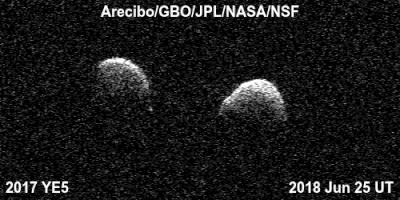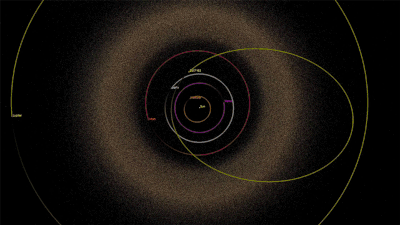2017 YE5
.gif) Radar images of binary asteroid 2017 YE5: top, Goldstone; bottom, Arecibo transmitting with Green Bank receiving | |
| Discovery | |
|---|---|
| Discovered by |
C. Rinner M. Ory B. Zouhair |
| Discovery site |
Oukaimeden Obs. (J43) Cadi Ayyad University Obs. |
| Discovery date | December 21, 2017 |
| Designations | |
| MPC designation | 2017 YE5 |
| Binary NEO · Apollo[1] | |
| Orbital characteristics [1] | |
| Epoch 23 March 2018 (JD 2458200.5) | |
| Uncertainty parameter 4 | |
| Observation arc | 0.57 yr (210 days) |
| Aphelion | 4.82 AU |
| Perihelion | 0.8171 AU |
| 2.82 AU | |
| Eccentricity | 0.7102 |
| 4.74 yr (1730 days) | |
| 349.0° | |
| 0.2081°/day | |
| Inclination | 6.21° |
| 103.96° | |
| 110.77° | |
| Earth MOID | 0.0206 AU |
| Physical characteristics | |
Mean diameter | 0.9 km (for each body)[2] |
| 19.3[1] | |
|
| |
2017 YE5 is the provisional name for a sub-kilometer, binary near Earth (Apollo) asteroid that passed within 16 lunar distances, 6 million kilometres (3.7×106 mi), from Earth on 21 June 2018,[1] which will be the closest approach for the next 170 years.[3] Each member of the binary has approximately equal mass, and is about 0.9 kilometres (0.56 mi) in diameter. The orbital period is 4.74 years (1,730 d), and the bodies revolve around their common barycenter with a period of 20–24 h.[2]
Discovery
The binary asteroid was discovered in December 2017 by amateur astronomers Claudine Rinner[4] and Michel Ory with observations provided by Cadi Ayyad University's Morocco Oukaimeden Sky Survey Telescope[5][6][7] (observatory director, Benkhaldoun Zouhair), and the Mount Lemmon Survey.[8] The asteroid was determined to be a near-equal mass binary asteroid using bistatic radar measurements from Goldstone, Arecibo Observatory and the Green Bank Observatory.[2][3]


References
- 1 2 3 4 Chamberlin, Alan. "JPL Small-Body Database Browser". ssd.jpl.nasa.gov.
- 1 2 3 Cofield, Calla; Wendel, JoAnna (12 July 2018). "Observatories Team Up to Reveal Rare Double Asteroid". NASA. Retrieved 12 July 2018.
- 1 2 Dvorsky, George (13 July 2018). "Newly Discovered 'Asteroid' Is Far Freakier Than Astronomers Expected". Gizmodo. Retrieved 18 July 2018.
- ↑ Davis, Jason (2018-07-24). "Planetary Society asteroid hunters help find rare type of double asteroid". www.planetary.org/blogs. The Planetary Society. Retrieved 2018-07-24.
- ↑ "Morocco Oukaïmeden Sky Survey". moss-observatory.org/. Société jurassienne d'astronomie. 2018-03-13. Retrieved 2018-07-13.
- ↑ Davis, Jason (2018-07-03). "Planetary Defense in the Moroccan Mountains". www.planetary.org/blogs. The Planetary Society. Retrieved 2018-07-28.
- ↑ Kaplan, Mat; Ory, Michel (2018-07-03). "An African Observatory Hunts Killer Asteroids". www.planetary.org/multimedia/planetary-radio. The Planetary Society. Retrieved 2018-07-28.
- ↑ "Goldstone Radar Observations Planning: 2017 YE5, 1996 AW1, 2010 NY65, and 2018 LK". echo.jpl.nasa.gov. Retrieved 18 July 2018.
External links
- 2017 YE5 at NeoDyS-2, Near Earth Objects—Dynamic Site
- Ephemeris · Obs prediction · Orbital info · MOID · Proper elements · Obs info · Physical info · NEOCC
- 2017 YE5 at the JPL Small-Body Database
.png)